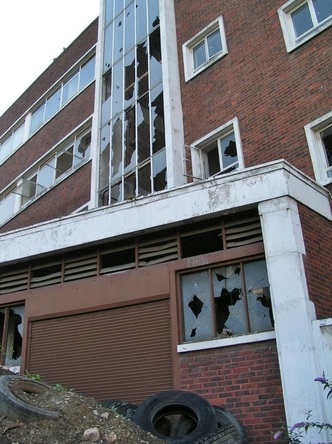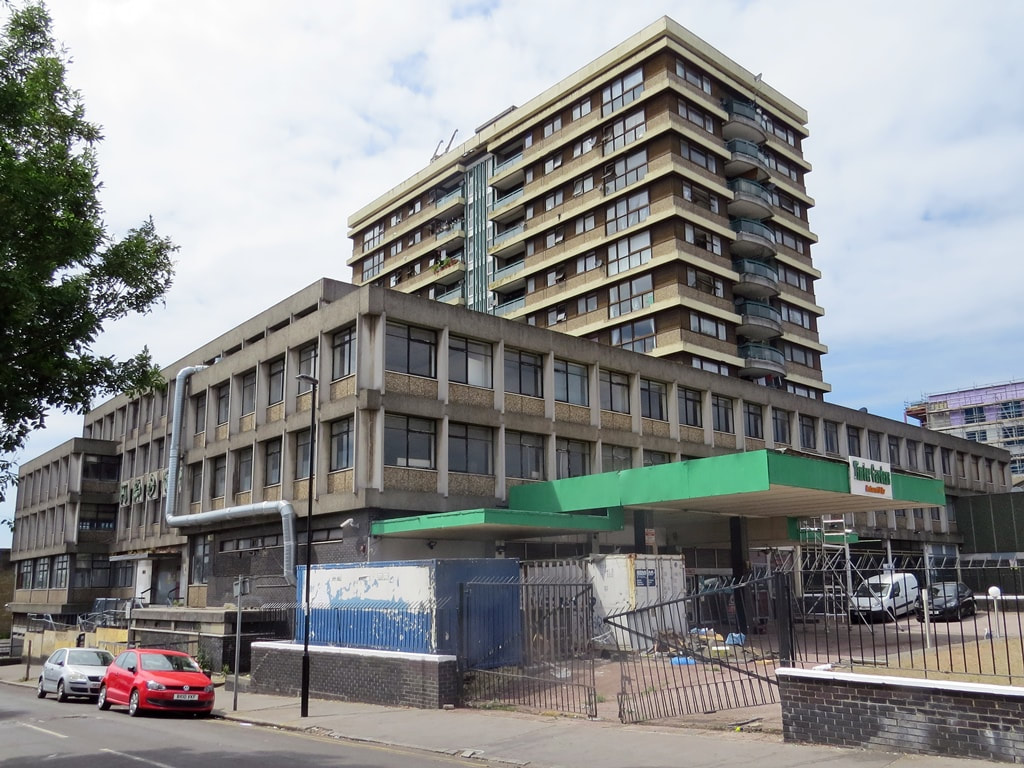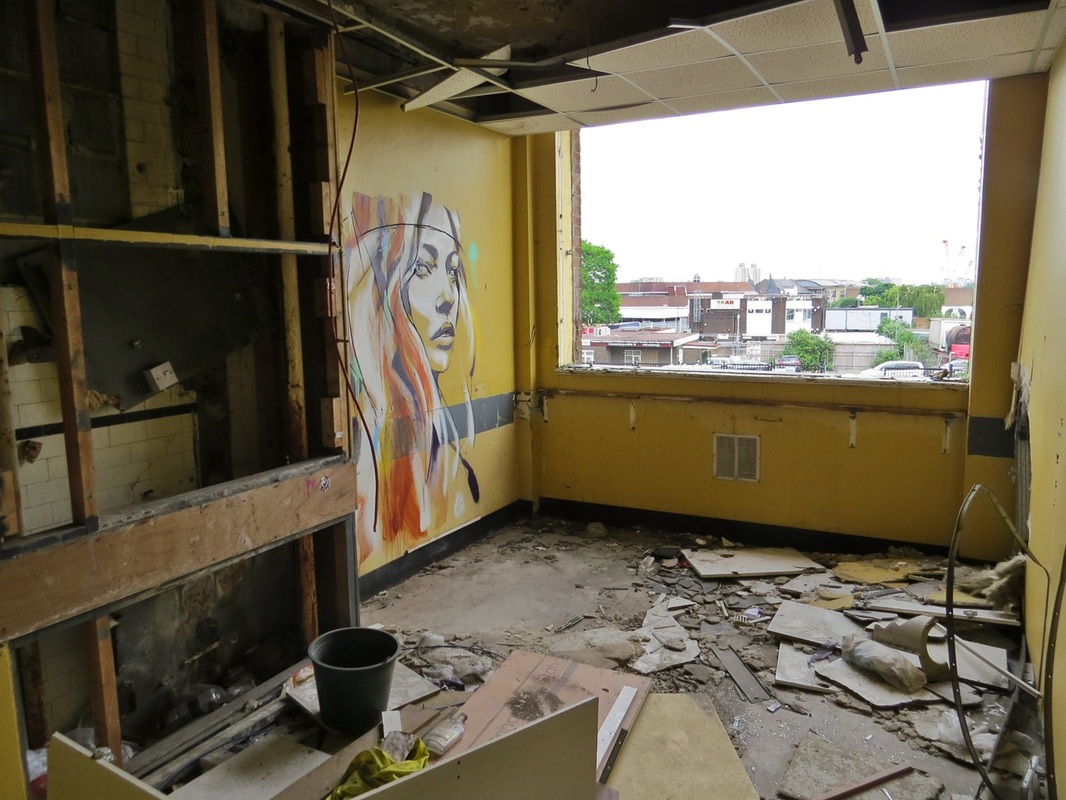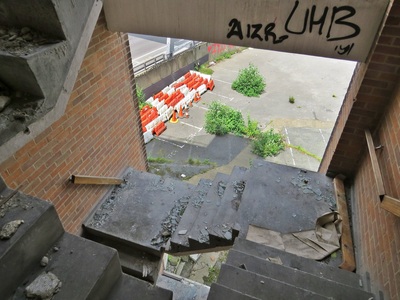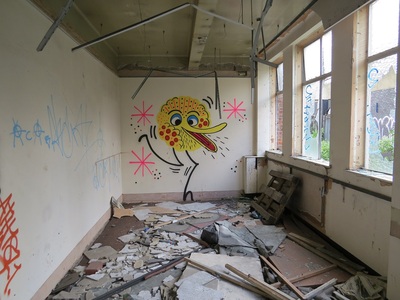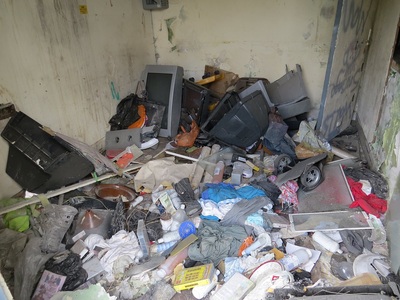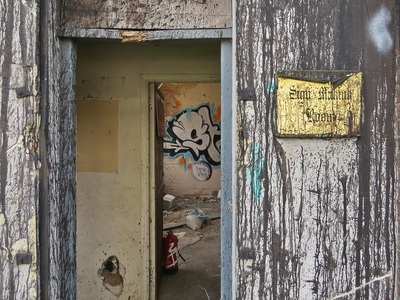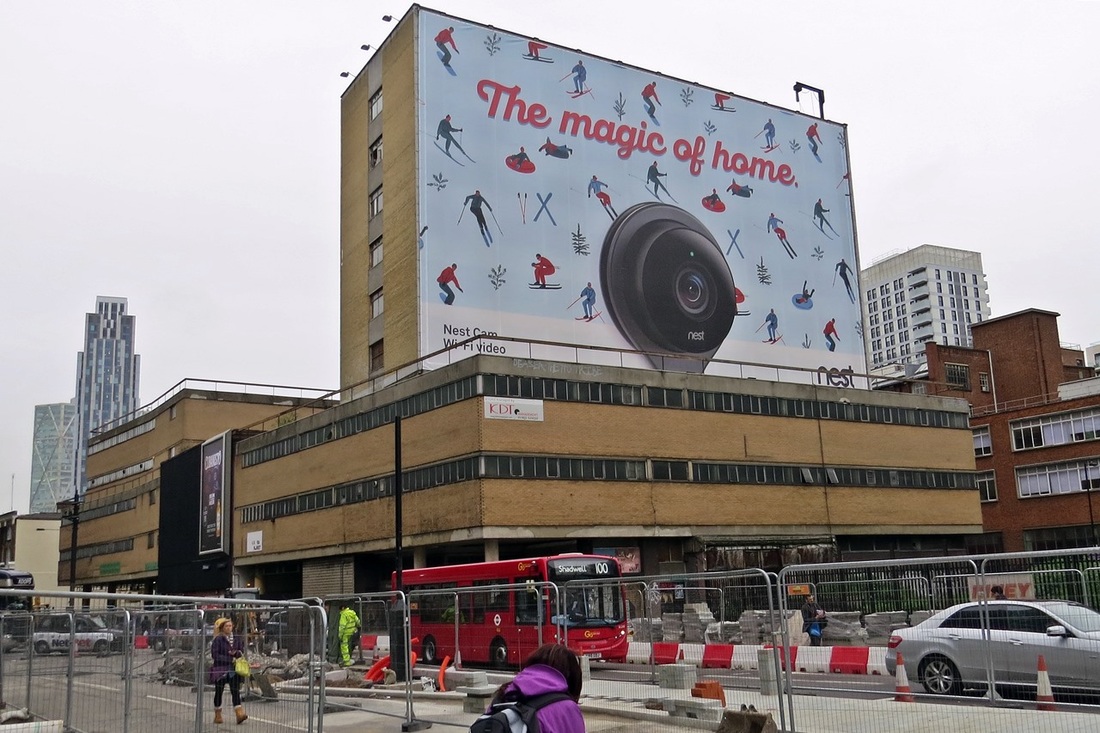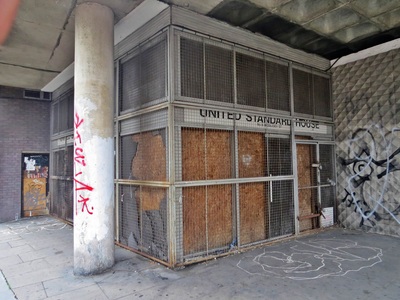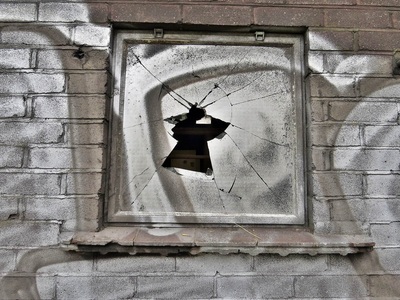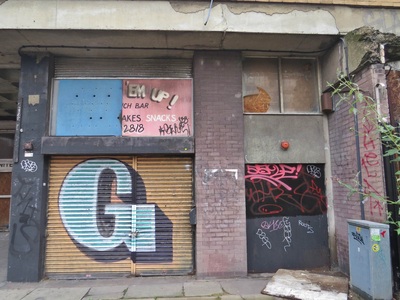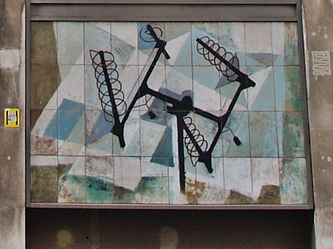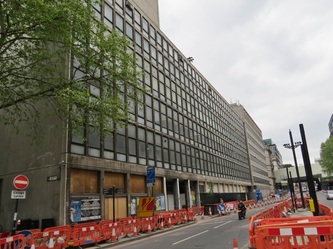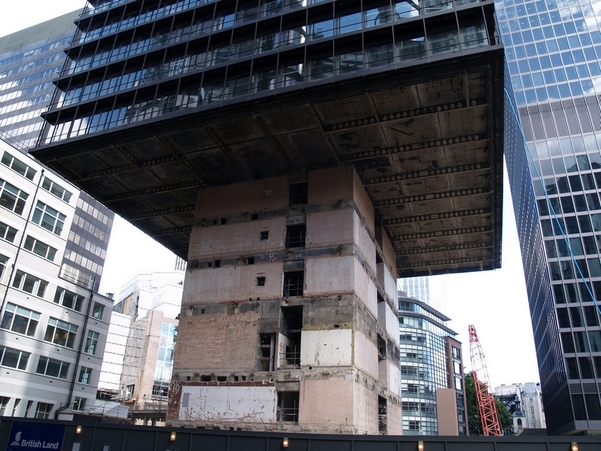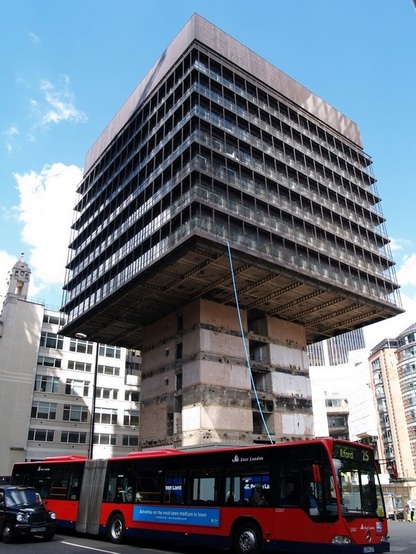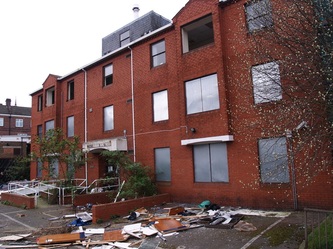Derelict London - Offices

There are many empty offices around London much of which are not left long enough to go into an advanced state of dereliction. They go vacant to await fairly swift demolition and then the site used to build new office buildings in their place.
Many of these buildings themselves were only built in the last 40 years and were built as unimaginative office complexes. When their short lifespan expires (according to the planners...) not many people miss them as they often lack character and haven't had time to build up interesting historical stories about them hence this section is a little shorter than others as there is not so much to say about the buildings on this page. Unless of course any of you have any information or social history relating to these places.
A commercial office lettings agent say that demand for London office space remains high, The following is from www.londonoffices.com:
"New figures have shown that the vacancy rates in London offices are at their lowest since the Lehman collapse. Property consultants Knight Frank released statistics that show that just 7.4% of London office space is sitting vacant, this is around 16.7 million square feet.Demand for office space within the UK capital has been growing over the past 2 years with a great deal of interest from international companies supporting the economy.
London 2012 has also been a huge contributing factor to interest in London office space. Newly built offices for the event will also be free to lease and buy following the Olympics. It is hoped that creative and digital companies will move into the area.
Similarly the area around Old Street roundabout has been dubbed the British equivalent of San Francisco’s Silicon Valley. Space is occupied by a diverse variety of companies from film-maker Benny Crime (who operates from an abandoned subway train) to big name digital media companies such as Last.fm and Tweetdeck. The recent development and construction of office buildings such as Bishopsgate Tower, the Shard and the Cheese- grater is also a promising sign of an improving economy in London. Demand for quality office space is high right now but it is expected to grow even more within the next few years. BNP Paribas Real Estate alone estimates that it will need an additional 1.6 million square feet of space in the future, this is the equivalent of four Shard buildings."
Many of these buildings themselves were only built in the last 40 years and were built as unimaginative office complexes. When their short lifespan expires (according to the planners...) not many people miss them as they often lack character and haven't had time to build up interesting historical stories about them hence this section is a little shorter than others as there is not so much to say about the buildings on this page. Unless of course any of you have any information or social history relating to these places.
A commercial office lettings agent say that demand for London office space remains high, The following is from www.londonoffices.com:
"New figures have shown that the vacancy rates in London offices are at their lowest since the Lehman collapse. Property consultants Knight Frank released statistics that show that just 7.4% of London office space is sitting vacant, this is around 16.7 million square feet.Demand for office space within the UK capital has been growing over the past 2 years with a great deal of interest from international companies supporting the economy.
London 2012 has also been a huge contributing factor to interest in London office space. Newly built offices for the event will also be free to lease and buy following the Olympics. It is hoped that creative and digital companies will move into the area.
Similarly the area around Old Street roundabout has been dubbed the British equivalent of San Francisco’s Silicon Valley. Space is occupied by a diverse variety of companies from film-maker Benny Crime (who operates from an abandoned subway train) to big name digital media companies such as Last.fm and Tweetdeck. The recent development and construction of office buildings such as Bishopsgate Tower, the Shard and the Cheese- grater is also a promising sign of an improving economy in London. Demand for quality office space is high right now but it is expected to grow even more within the next few years. BNP Paribas Real Estate alone estimates that it will need an additional 1.6 million square feet of space in the future, this is the equivalent of four Shard buildings."
Croydon CR0 - Zodiac House
Zodiac House was built as offices built in the 1960s and has been long term derelict. The development also incorporates Zodiac Court, an 8 storey block of flats above it which is still occupied. The block's claim to fame is that TV sitcom Peep Show starring David Mitchell and Robert Webb was filmed on location for the first two series in one of the flats. It is said that they only stopped filming in Zodiac Court when the landlords banned them because they through it was harming the building’s reputation....
Zodiac House was offices for various companies over the years including Abbey Life. Since the late 1980s it has been empty with plans at one point for converting it into a hotel though in 2017 permission was granted to convert it into flats though no progress appears to have been made yet. The ground floor facing London Road (with the green canopy) was a car showroom for many years and is currently a restaurant.
Zodiac House was offices for various companies over the years including Abbey Life. Since the late 1980s it has been empty with plans at one point for converting it into a hotel though in 2017 permission was granted to convert it into flats though no progress appears to have been made yet. The ground floor facing London Road (with the green canopy) was a car showroom for many years and is currently a restaurant.
Bromley By Bow, E3 - Brown & Tawse Offices
This land sitting on a valuable plot beside the A12 opposite Bromley By Bow tube station has been derelict for a few years with the decaying 5 storey office block becoming quite a local landmark for drivers on the Blackwall Tunnel Approach Road. Regarded by many as an eyesore, it’s windows mostly gone and debris hanging from the ceiling & scattered along the floors, removed stair-rails and a gaping open liftshaft leaving the whole place as quite dangerous to venture inside. This does not deter a handful of homeless people living in the upper floors.
The site used to belong to an engineering firm called Brown & Tawse though the date they moved out cannot be confirmed. A couple of people on Derelict London Twitter have mentioned that a scaffolding firm (possibly named Ellis & Grier?) occupied the site for a while after Brown & Tawse.
The proposed uses of the site which emcompasses a larger surrounding area comprises a new Tesco store, a school, and residential, retail and parkland areas.Historical mapping has identified several potential sources of contamination on the whole site including two chemical works, an asbestos works, a steam and boiler tank works, a jute spinning mill, a number of Wharves, railway lines, tanks and an infilled moat.
Paul Olivert writes:
"I was looking at the photos and it brought back so many memories for me. I used to work in the building late 80's early 90's. I worked in the tube and fittings department. During the 1990's my department moved to West Horndon. The recession hit in the 1990's and I was made redundant. Opposite the building used to be the staff canteen. We used to go there every lunchtime.On occasions we used to go to the pub opposite, the Imperial Crown. Mainly Fridays and seeing Jimmy Fagg. Sadly the pub has gone. Its flats now."
Next to the office block is a storage building and a two storey older building believed to date back to the 1940s. The gold sign on the older buiding says "Sign Making Room"
New Hotel Site -Aldgate, E1
Behind the site of the former Aldgate East Underground Station entrance (see London Transport page) between Middlesex Street & Goulston Street are some vacant 1960s buildings (including offices once occupied by United Standard Insurance) and an undercover car park and a car-wash. Proposals are to demolish all these buildings and to make a large development of a 395 room hotel and offices on this land and that on the open space which is the old tube station entrance.
The site lies within an archaeological priority area.Medieval quarry pits were discovered as part of an archaeological evaluation of the site in 1999 The evaluation also found 19th century basement foundations truncating 15th–18th century walls,cellars & foundations.
Below are some interior and roof pics of the Aldgate site taken by Bertie in late 2015.
LATHAM HOUSE - THE MINORIES EC3
Some modern offices next to Aldgate Bus Station that have been empty for a number of years. There are many derelict office blocks in the centre of London but there are always cranes in the skyline with the construction of new offices.
The Fleet Building (The New Central Telegraph Office) - City of London EC2
The Fleet Building was London’s largest telephone exchange when it opened in 1961.It was the largest building to be built for the Post Office since the war - these were the days when the Post Office was a government department responsible for both Posts & Telecommunications.
The building is named after the subterranean River Fleet which runs in front of the building on Farringdon Street. There were once 600 staff employed here. Long before the days of email and Twitter this building handled up to 25000 telegrams a day.
The site has been acquired by Goldman Sachs in order to expand its European HQ in London.There were plans to demolish this unloved and dirty building although there was a complication in that nine ceramic murals (by Dorothy Annan) on the outside front wall of the building were granted Grade II listed status by the Department for Culture Media and Sport after English Heritage said the murals, which show telecommunications technology, are of “historic interest” to the telecoms industry and have “relative rarity as surviving works of 1960s mural art”. In September the murals were transfered to City Corporation ownership and relocated to an elevated walkway on the Barbican Estate and that a dowry of £100,000 provided by Goldman Sachs,has been set aside in a ring fenced fund to provide for future maintenance and repair. The Fleet building has since been demolished and construction of the new offices was completed in late 2019.
Graham Sinclair writes: "My first job in 1969 was working there until 1976. The Fleet Building was not only the largest telephone exchange but also the HQ for the International Telex Exchange (long before the days of testing etc!) The telephone exchange covered the old fleet Street numbers plus taking 999 calls from many other exchanges in London. Although based in the London City Area, it was in fact the HQ for the London North Central Area, which stretched out as far as Clissold area (Nr Stoke Newington). It was the office of the Telephone later General Manager and was known as North Central TMO or later GMO. All the executives were housed very comfortably on the seventh floor. A very large staff restaurant on the ground floor. Two basements held many sporting facilities for the staff. I remember many a game of snooker there! A large underground staff car park was there too.I hope this breathes a bit of life back into a very happy building. Sadly demolition has taken place and it is all gone now. "
More "Modern" Empty London offices in the City of London
CITY OF LONDON EC3 - P & O BUILDING
Built in 1969, with 15 storeys above ground and three below, this building was considered at the time to be one of the most complex glass-fronted structures in England. It was extensively damaged by a Provisional Irish Republican Army bomb attack in 1992, and subsequently had to be reclad. Now it is being demolished to make way for a much taller, 48-storey tower, destined to be the tallest building in the City until the completion of the neighbouring Bishopsgate Tower. The distinctive wedge-shaped profile of the new building has already led to it being nicknamed the Cheese Grater. The project is costing £286 million. The demolition procedure for the old building is unusual, being conducted from the bottom upwards, rather than the other way round, leaving the building’s concrete core exposed. This is because of the unique way in which the building was constructed: the floors are supported by a beam hanging from the roof rather than being supported by columns from the ground. *** The building has now been completely demolished *** |
Paul Talling's Derelict London - all photographs are copyright © 2003-2024
Click the envelope icon to join the mailing list for occasional news on website updates, new book releases and Paul's guided walking tours. Follow Derelict London on Facebook and Twitter
Please do not contact me with property/ filming/photo shoot location queries
Click the envelope icon to join the mailing list for occasional news on website updates, new book releases and Paul's guided walking tours. Follow Derelict London on Facebook and Twitter
Please do not contact me with property/ filming/photo shoot location queries


